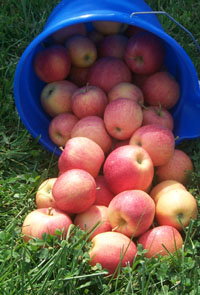Apple Time in Kentucky
Apple Time in Kentucky

There’s nothing quite like biting into a crisp, juicy apple fresh from the tree, and just such apples are abundant this fall in Kentucky.
“Our apples always taste better than those shipped in from Washington, Oregon or California because ours are tree-ripened, thus are packed with more flavor,” said Joe Masabni, a horticulture specialist with the University of Kentucky Cooperative Extension Service.
Locally grown apples become available in early July and the season progresses with many varieties now ripe and ready for eating. The majority of apples grown in Kentucky are sold for the local market, and excess apples usually are used to make cider, he said.
The 2003 crop is higher in quantity and quality than last year’s crop, Masabni said. But it hasn’t been a crop without challenges.
In eastern Kentucky, some apple trees suffered damage from late frosts reducing their production, he said. The wet spring also had commercial producers and backyard growers across the state scrambling to control diseases on their crops in a timely manner.
“For the crop that we have this year, the size and the color is exceptional,” Masabni said. “I went to the state fair and there was a wide variety of quality apples displayed.”
Size, shape, color, and lack of disease blemishes all contribute to making a high quality apple. Management in terms of pruning, trimming, disease and insect control, play a role in quality. So, too, does the overall health of the tree.
There are some diseases that continue to be a problem every year such as fire blight, which has to be controlled before its effects show up in the trees. Once the disease is evident, all a grower can do is cut off the diseased branches, especially after fruit set.
Many of the backyard growers who call Masabni have fire blight problems, he said. The wet spring helped contribute to the amount of fire blight this year.
Coddling moth and San Jose scale are two insect problems that plague Kentucky orchards. Some growers had a serious problem last year, but with changing pesticides and adhering to timely applications they were able to attain better control.
The UK Research and Education Center in Princeton, where Masabni is located, is among a number of locations across the country conducting rootstock evaluations to see which rootstocks work better in each area. The rootstock is the lower portion of the tree that the variety is grafted onto. Among the benefits of rootstocks are disease resistance and support, but mostly, dwarfing, which can produce a tree that is 15 percent of the standard tree size.
The orchard at Princeton contains several research plots testing both semi-dwarfing rootstocks as well as high density plantings using dwarfing rootstocks. High density planting is a relatively new production method which allows more trees to be planted per acre.
In addition, research concluded in 2002 on a project comparing two training and pruning methods - French axe and Slender Spindle – and which worked best for Kentucky. The research, funded by the Kentucky State Horticultural Society, showed no differences between the two methods, Masabni said.